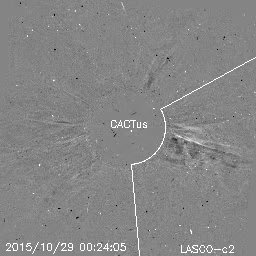At last, another proton event in 2015! It is only the 4th event so far this year, the other three having occurred resp. on 18, 22 and 27 June (Note 1). With 23 pfu (Note 2), the greater than 10 MeV (Note 3) proton flux constituted only a minor radiation event (Note 4). The largest event this year took place on 22 June (1070 pfu), and the largest proton event so far this solar cycle was recorded on 8 March 2012 (6530 pfu, following an X5 flare from NOAA 1429 - Note 5).

Judging from SDO's AIA193 imagery, the source of this proton event was an eruption on the solar backside, slightly beyond the southwest solar limb as seen from Earth, on 29 October probably between 02:30 and 03:00UT. Unfortunately, due to a lack of STEREO-A imagery, the true location of the eruption cannot be pinpointed. A complex coronal mass ejection (CME) was associated with this event and was first visible in LASCO/C2 coronagraphic imagery at 02:36UT. It had no earth-directed component. Notice the dots on the image: these are no stars, but genuine energetic particles (protons) slamming into the camera's pixels.

The increased proton flux levels were also recorded by the Rosetta spacecraft, which is still near that comet with the unpronounceable name (see the ESA webpage on Rosetta for more info). It has an onboard instrument (Note 6) to record energetic particles and which is similar to that on board the Integral satellite (see the ESA webpage on Integral). Integral is orbiting Earth since 2002, passing regularly through the Earth's radiation belts. These can be seen as the spikes in the graph underneath on 28 and 31 October. A side-by-side comparison reveals that a small peak was recorded by Integral on 29 October, whereas Rosetta recorded merely a modest hump (see the black arrows). The reason for the difference is that Integral (and thus Earth) is better connected to the location of the eruption than Rosetta is, with its magnetic footpoint closer to the eruption site than Rosetta's (indicated by the red arrow). This can also be deduced from the Parker spirals,i.e. the magnetic field lines emanating from the Sun.

Note 1 - The first proton event of 2015 was also discussed in this news item, containing also more info on proton events and their general effects.
Note 2 - pfu: proton flux unit. This is the number of particles registered per second, per square cm, and per steradian.
Note 3 - 10 MeV = 10 million eV. The eV (electron volt) is a very tiny amount of energy corresponding to about 0.16 billionth of a billionth of a Joule. For comparison, a flying mosquito has a kinetic energy of about a trillion eV (= 1000 billion eV).
Note 4 - Classification of proton events is done according to NOAA's radiation scales.
Note 5 - A list of proton events is maintained by NASA.
Note 6 - SREM: Standard Radiation Environment Monitor.
 |
 |
 |





